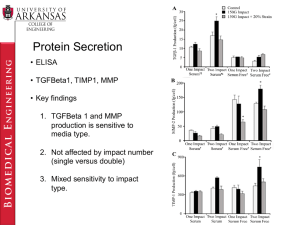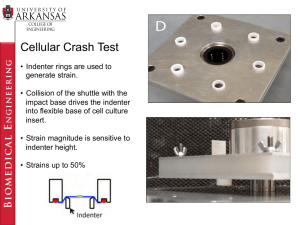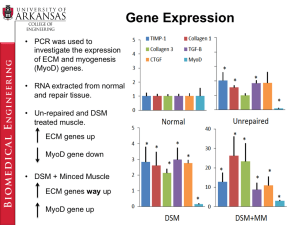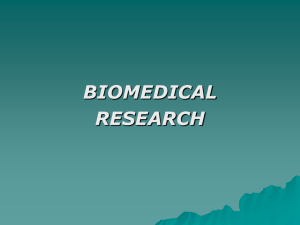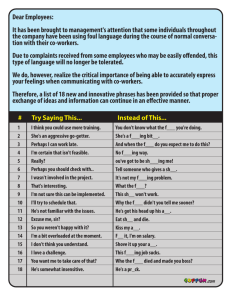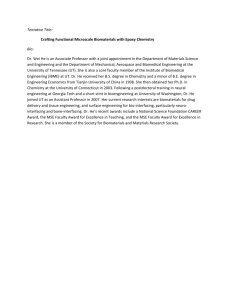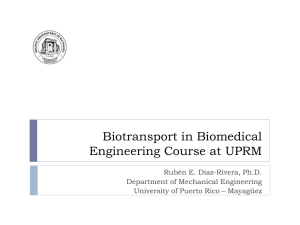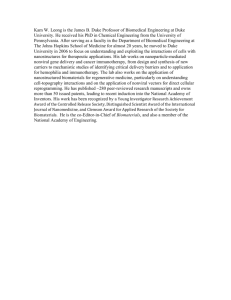Exploring ECM in Muscle Repair and Brain Injury ngineering
advertisement
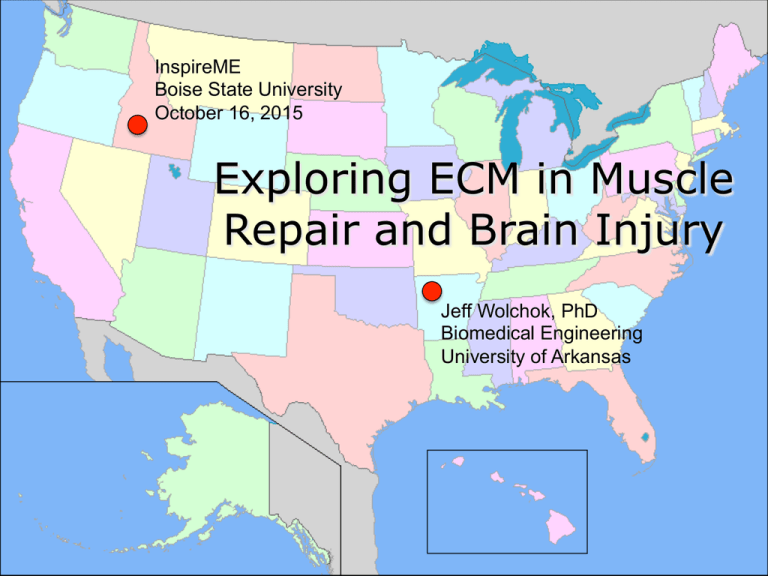
Biomedical E ngineer ing InspireME Boise State University October 16, 2015 Exploring ECM in Muscle Repair and Brain Injury Jeff Wolchok, PhD Biomedical Engineering University of Arkansas Biomedical E ngineer ing Extracellular Matrix • Proteins and sugars that surround cells • Collagen is most abundant • Provides strength • Supports cell survival • Different between tissues Biomedical E ngineer ing Traditional Synthetic Biomaterials Metals Polymers Ceramics Metals Biomedical E ngineer ing Ex. Titanium • Strong • Some flexibility = Ductile • Good conductors or heat and electricity • Can corrode 4 Ceramics Biomedical E ngineer ing Ex. Alumina • Al2O3 • Excellent Wear Resistance • Bearing Surfaces • Orthopedic & Dental Applications • Can be brittle 5 Polymers Biomedical E ngineer ing Ex. Polyethylene • Light • Flexible • Good insulators of heat and current • Moderate wear resistance 6 Biomedical E ngineer ing What Do These Biomaterials Share in Common? The answer is: that they were not originally engineered for biomaterials applications! Humans are not built from traditional engineered materials. Injury and Healing Biomedical E ngineer ing 1. Injury with tissue and vascular damage 2. Bleeding and clotting – Coagulation Cascade (Minutes to Hours) 3. Acute Inflammation – Neutrophils, Macrophages, and fibroblasts (Hours to days) 4. Pink highly vascularized granulation tissue replaces the provisional matrix (days to weeks) – fibroblast cells 5. The tissue is remodeled back to its original state Biomedical E ngineer ing Synthetic Materials Alter the Healing Response 1. Injury with tissue and vascular damage 2. Bleeding and clotting – Coagulation Cascade (Minutes to Hours) 3. Acute Inflammation – Neutrophils and Macrophages (Hours to days) Biomedical E ngineer ing Synthetic Materials Alter the Healing Response 1. Injury with tissue and vascular damage 2. Bleeding and clotting – Coagulation Cascade (Minutes to Hours) 3. Acute Inflammation – Neutrophils and Macrophages (Hours to days) 4. Chronic Inflammation – Macrophages cant remove the synthetic biomaterial so they persist at the wound site PLGA Inflammatory foreign body giant cells Biomedical E ngineer ing Synthetic Materials Alter the Healing Response 1. Injury with tissue and vascular damage 2. Bleeding and clotting – Coagulation Cascade (Minutes to Hours) 3. Acute Inflammation – Neutrophils and Macrophages (Hours to days) 4. Chronic Inflammation – Macrophages persist at the implant site 5. Fibroblasts deposit a fibrous encapsulation layer Biomedical E ngineer ing What Do These Biomaterials Share in Common? The answer is: that they were not originally engineered for biomaterials applications! Synthetic materials are incapable of regenerating damaged tissue. There is a need for advanced ECM biomaterials which mimic the structure, composition, and function of biological tissues. Clinical Target: Volumetric Muscle Loss Biomedical E ngineer ing Case Report • IED injured 22 Year old soldier • Upper extremity injury with significant loss of muscle Objective • Provide surgeons with a treatment option for VML injuries Biomedical E ngineer ing Skeletal Muscle • Highly organized • Multinucleated fibers • Fibers and bundles are surrounded by ECM Guiding Principle ECM provides critical regenerative cues during VML healing. ECM Biomaterials Biomedical E ngineer ing Engineering Objective • Build ECM materials that restore the regenerative cues provided by the native muscle ECM Top Down ECM collected from decellularized skeletal muscle • Strip the cell from whole muscle • Collect the remaining ECM Bottom Up • Culture muscle cells • Collect the ECM that they secrete (engineered ECM)
